Easy Homemade Sauerkraut
Last Updated August 12, 2017 · First Published October 16, 2014
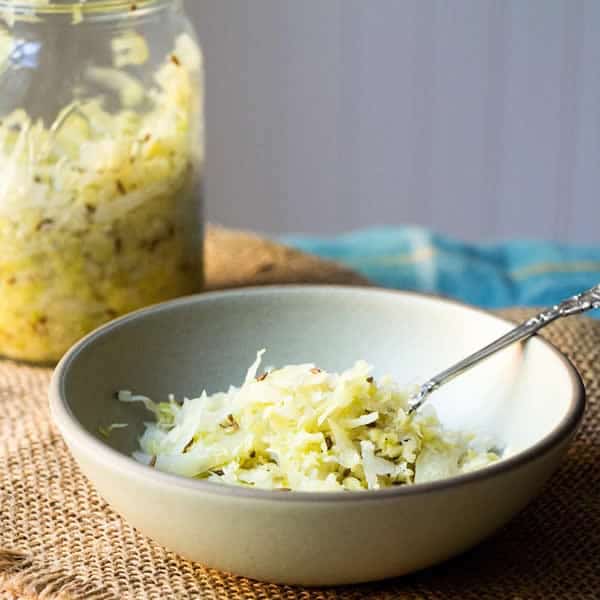
A few weeks ago, some friends visited us for the weekend in Tahoe, and we got to talking about healthy snacks. It turns out one of their favorite healthy snacks is sauerkraut.
“Seriously?” I asked, my eyes bulging a bit at the thought.
“Yep. We make a fresh batch every week and leave it on the counter to snack on. You should try it.”
I’d been thinking more along the lines of reduced sugar cookies made with coconut oil for a healthy snack. But anyone who knows me knows I’m usually game to try something new. And I had never made my own sauerkraut.
I grew up with sauerkraut – it showed up regularly at our house alongside pork chops on top of platters of mashed potatoes. But it was only recently that I became aware of its health properties.
It’s all about fermentation. Ferments with live lactic-acid producing bacteria, lactobacilli, intact are particularly beneficial to digestive health, immune function, and general well-being.
Too much science? Bear with me for a moment.
Lactobacilli are ubiquitous, found on the surface of all living things, but particularly plentiful on the leaves and roots of plants growing in or close to the ground. Through the fermenting process, the starches and sugars in fruits and vegetables are converted into lactic acid. As the lactobacilli multiply, they enhance the digestibility and nutrition of the food being fermented, and promote the growth of healthy flora in the intestine. In a nutshell, fermented foods tend to be very good for the gut. It’s written that Tiberius, of Roman fame, always carried a barrel of sauerkraut with him on long voyages to protect himself from intestinal infections, so the Romans figured this out long ago.
If you’re interested in delving into the science and nature of fermented foods, The Art of Fermentation by Sandor Katz, a true expert on fermenting, is a must read. Another great resource, a little less technical, is Nourishing Traditions by Sally Fallon.
Some general tips when fermenting I’ve picked up:
- At it’s most basic, fermenting just requires salt to be added to fruits or vegetables to 1) draw out their juices and 2) to inhibit the growth of bad bacteria. Once the fermentation process begins, lactobacilli multiply like crazy, and the need for the salt is eliminated. But if you’ve just made some cheese and happen to have some fresh whey on hand, it can be used in place of some or all of the salt. Whey is super rich in lactic acid and lactic-acid-producing bacteria. But don’t use dried whey for this.
- Keep the food being fermented completely submerged in its juices during fermentation to eliminate any oxygen contact with the food. If you don’t have enough juices, add a little water. I insert a smaller jar into the jar containing the food and tape it down to keep the food submerged.
- If you can’t keep the food completely submerged, then close the food up tightly in a jar for a few days, and leave it on the counter. Be sure to leave one-inch head room to allow the vegetable to expand a bit during fermentation.
- In winter, it may take longer to ferment. Conversely, at summer’s peak, the heat will facilitate a faster ferment. It can take anywhere from 4 – 7 days to achieve the level of fermentation you want. Start tasting it after the third day.
- Small bubbles are normal after one day – it’s a sign of fermentation. If you see scum or mold forming, don’t worry. That’s normal too. Just remove it with a spoon and let the process continue.
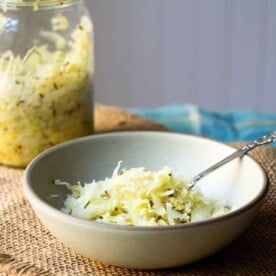
Easy Homemade Sauerkraut
Ingredients
- 1 large head of cabbage, weighing at least 2 pounds
- 1 tablespoon sea salt
- 1 teaspoon caraway seeds
Instructions
- Slice the head of cabbage in half and cut out the core. Using a mandolin or sharp knife, shred the cabbage into thin slivers.
- Place the shredded cabbage in a large, wide bowl and sprinkle the salt over it. Toss to coat. Using a jar filled with something dense, like jam, pound the cabbage until the juices are released, about 10 minutes. Anything heavy and solid will work for this pounding.
- Toss with caraway seeds and place in a quart-sized mason jar, pressing firmly down to tightly pack the cabbage. I recommend a small jar that fits into the mouth of the mason jar for this.
- When all the cabbage is packed into the mason jar, press the smaller jar down to submerge the cabbage in its juices, and tape it into place. Cover with some cheesecloth and store on the counter for three days.
- Test the sauerkraut after 3 days. If you prefer a stronger flavor, continue fermenting. I stopped at around 6 days. Place a lid on the jar and store in the refrigerator for up to several months.
- Snack on it regularly. Your gut will thank you.
Nutrition
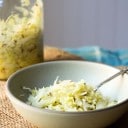
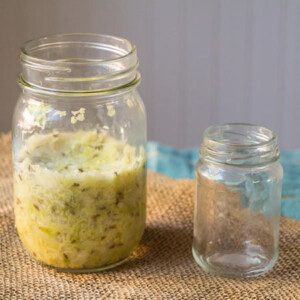
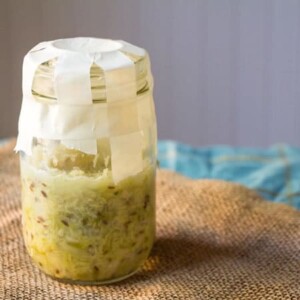

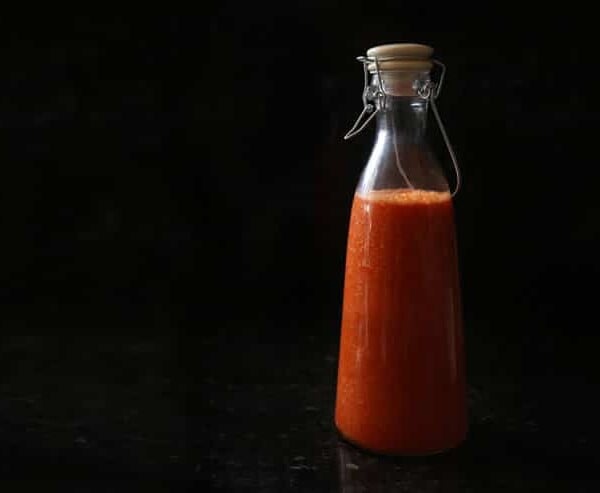
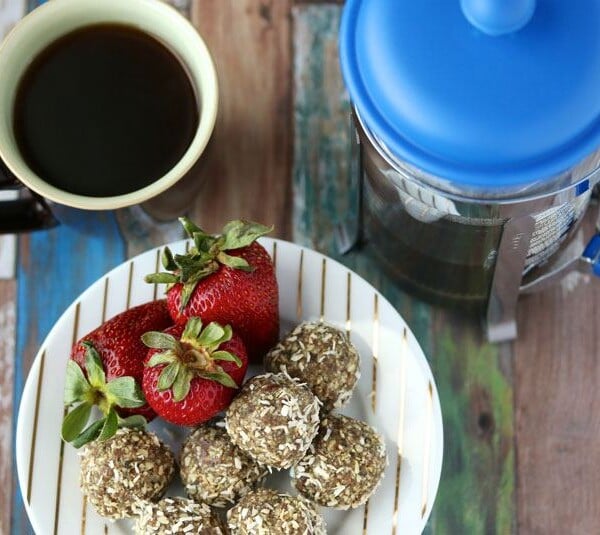
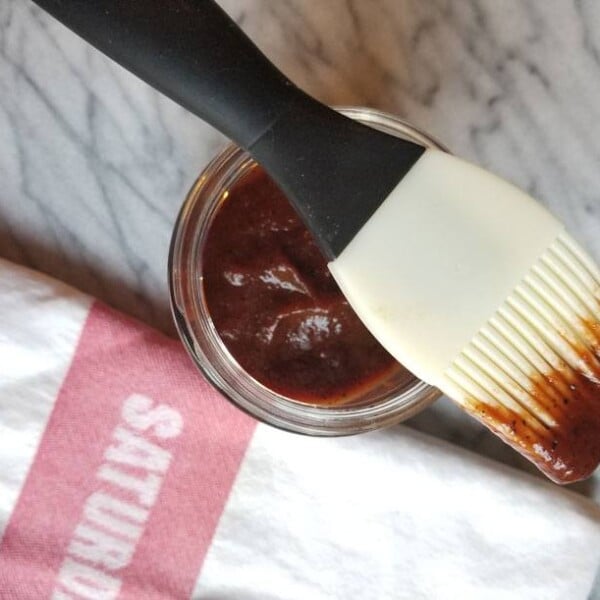
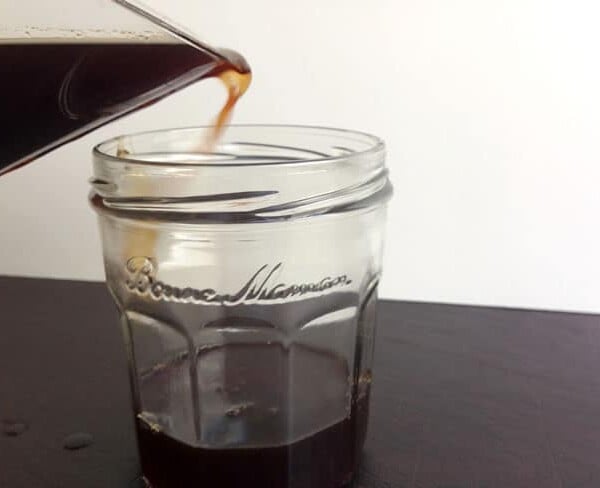















I was under the assumption that it had vinegar in it!?
Hi Susan! No, no vinegar. The sour flavor is from the fermenting process. If you want to amp up the sour flavor, I recommend either letting it ferment longer or just before serving, add little cider vinegar if you want.
As a note – I’m so excited so many of you are trying out making your own sauerkraut!! As a result of further research and experimenting, the recipe above has been adjusted for some ratio guidelines for cabbage to salt. The theory is that if there’s too much salt (exceeding 1 Tablespoon per 2 lbs of cabbage) that the salt can neutralize the acid forming, resulting in a failed fermentation. Sandor Katz uses more salt than this, as does Sally Fallon, (and me), but in order to ensure a successful outcome, we’ve adjusted the recipe.
I like it, thanks. This is a good start, I will add a little white wine after I put it in the fridge and drain off the excess liquid.
Thanks for the feedback! I’m really happy you tried it, and I love the idea of finishing it with a little white wine!
Susan I saw Wise Sons make sauerkraut at a session at a conference – such a simple wonder right in front of our eyes! Thanks for sharing this fantastic method and recipe!
What a treat that must have been, Beth! I would love to see Wise Sons in action!